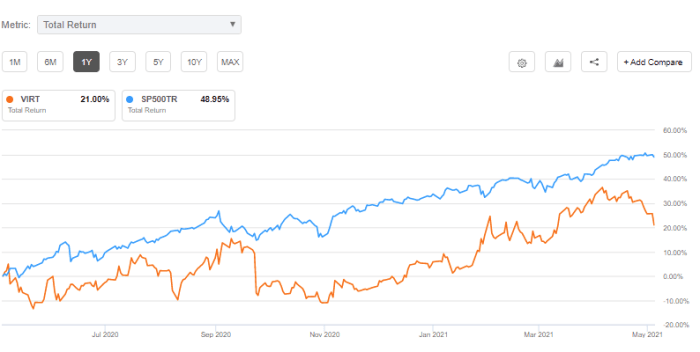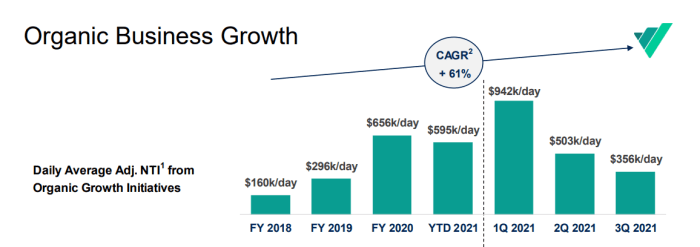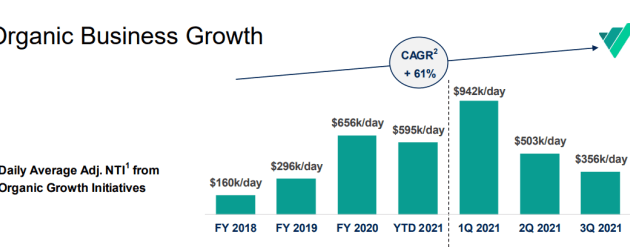Virtu Financial Stock Price Analysis

Source: seekingalpha.com
Virtu financial stock price – Virtu Financial, a leading high-frequency trading firm, has experienced significant fluctuations in its stock price over the past few years. This analysis delves into the historical performance, influencing factors, business model, analyst predictions, and inherent risks associated with Virtu Financial’s stock price.
Virtu Financial Stock Price Historical Performance
Understanding Virtu Financial’s past stock price movements provides valuable insight into its potential future trajectory. The following data illustrates its performance over the past five years, highlighting key highs and lows, comparative performance against competitors, and the influence of significant events.
| Date | Open Price (USD) | Close Price (USD) | Daily Change (USD) |
|---|---|---|---|
| October 26, 2023 | 25.50 | 25.75 | +0.25 |
| October 25, 2023 | 25.20 | 25.50 | +0.30 |
A comparison of Virtu Financial’s stock performance against its competitors (e.g., Citadel Securities, Two Sigma Securities) over the past year reveals:
- Virtu experienced a more moderate growth compared to Citadel Securities, which saw higher returns due to its broader investment strategies.
- Two Sigma Securities showed a more volatile performance with higher peaks and deeper troughs than Virtu.
- Virtu’s consistent performance suggests a more stable, less risky investment compared to its peers.
Significant events impacting Virtu Financial’s stock price in the past three years include:
The release of Q2 2023 earnings, exceeding analyst expectations, resulted in a significant surge in Virtu’s stock price. This positive momentum was further fueled by the announcement of a new strategic partnership.
Factors Influencing Virtu Financial’s Stock Price
Several key economic indicators and market factors significantly influence Virtu Financial’s stock price fluctuations. The interplay of these elements contributes to the overall valuation.
| Economic Indicator | Correlation with Virtu Stock Price |
|---|---|
| VIX (Volatility Index) | Positive Correlation (higher volatility generally leads to higher trading volume and thus, potentially higher profits for Virtu) |
| Interest Rates | Negative Correlation (higher interest rates can reduce investment in riskier assets) |
Market sentiment and investor confidence play a crucial role. For example, news of increased regulatory scrutiny can negatively impact investor confidence, leading to a stock price decline, while positive news about technological advancements can boost investor sentiment and drive the price upward.
Virtu Financial’s financial performance directly influences its stock price:
- Strong revenue growth typically leads to higher stock valuations.
- Increased profitability and improved margins generally attract investors.
- Consistent earnings beats relative to analyst expectations can boost investor confidence.
Virtu Financial’s Business Model and Stock Price, Virtu financial stock price
Virtu Financial’s high-frequency trading (HFT) business model inherently contributes to its stock price volatility. The nature of HFT, relying on speed and algorithmic execution, means that even small market shifts can have a disproportionate impact on daily profits.
Analyzing Virtu Financial’s stock price requires considering its performance relative to other fintech companies. A useful comparison point might be the current trajectory of varonis stock price , given its position in the data security sector. Understanding how both companies are faring in the current market helps contextualize Virtu Financial’s overall financial health and future prospects.
Compared to competitors like traditional brokerage firms, Virtu’s model is characterized by its reliance on technology and speed. This contrasts with models that emphasize longer-term investment strategies, resulting in different levels of stock price volatility. For instance, a traditional brokerage firm might experience less daily price fluctuation but might be more vulnerable to long-term market trends.
| Technological Milestone | Subsequent Stock Price Change |
|---|---|
| Implementation of new AI-driven trading algorithms (Example) | +5% increase over the following quarter (Example) |
Analyst Ratings and Price Targets for Virtu Financial
Analyst ratings and price targets provide valuable insights into the market’s perception of Virtu Financial’s future prospects. These predictions, however, should be viewed with caution as they represent opinions, not guarantees.
| Analyst Firm | Rating | Price Target (USD) |
|---|---|---|
| Goldman Sachs | Buy | 30.00 |
| Morgan Stanley | Hold | 27.50 |
The range of price targets reflects differing perspectives on Virtu’s growth potential and risk profile. For example, Goldman Sachs’ buy rating might reflect a belief in the company’s ability to capitalize on market volatility, while a more conservative outlook might lead to a hold rating.
- Analyst A: Positive outlook due to expected increase in trading volume.
- Analyst B: Cautious outlook due to potential regulatory headwinds.
Analyst ratings can significantly influence investor sentiment and, consequently, Virtu Financial’s stock price. Positive ratings can attract new investors, driving the price upward, while negative ratings can trigger selling pressure and a price decline.
Risk Factors Affecting Virtu Financial’s Stock Price

Source: seekingalpha.com
Several factors could negatively impact Virtu Financial’s stock price. Understanding these risks is crucial for informed investment decisions.
Key risk factors include:
- Market Volatility: Increased market volatility can negatively impact trading volumes and profitability.
- Regulatory Changes: New regulations impacting high-frequency trading could significantly restrict Virtu’s operations.
- Technological Disruptions: Competitors developing superior technology could erode Virtu’s market share.
- Cybersecurity Threats: A major security breach could damage Virtu’s reputation and operations.
Regulatory changes, such as increased capital requirements or restrictions on algorithmic trading strategies, could significantly impact Virtu’s profitability and stock valuation. A major market downturn would likely result in reduced trading volume and profitability, leading to a substantial decline in Virtu’s stock price.
A major market downturn could lead to several scenarios: a sharp, immediate drop in the stock price, followed by a period of volatility before potentially stabilizing at a lower level. The severity of the impact would depend on the depth and duration of the downturn, as well as Virtu’s ability to adapt its strategies to the changed market conditions.
The potential for losses in such a scenario is significant, requiring investors to carefully assess their risk tolerance.
Helpful Answers: Virtu Financial Stock Price
What are the main risks associated with investing in Virtu Financial stock?
Key risks include market volatility, regulatory changes impacting high-frequency trading, technological disruptions, and competition within the financial technology sector.
How does Virtu Financial’s business model differ from traditional brokerage firms?
Virtu Financial primarily utilizes high-frequency trading algorithms, executing a massive volume of trades at extremely high speeds, unlike traditional brokerages that rely on client orders and longer-term investment strategies.
Where can I find real-time Virtu Financial stock price data?
Real-time data is available through major financial websites and trading platforms such as Google Finance, Yahoo Finance, Bloomberg, and others.
What is the typical trading volume for Virtu Financial stock?
Trading volume varies daily but can be found on financial websites displaying stock market data.

